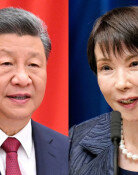Some Bank Machine Coins Come Up Fake
Some Bank Machine Coins Come Up Fake
Posted May. 29, 2006 03:00,
On May 25, a Dong-A Ilbo team visited a bank branch office in Seoul after being informed that some of the coins exchanged at a bank are counterfeits. After mixing the real and fake coins, the team asked to roll 100-won coins by 50 pieces and 500-won coins by 40 pieces.
The machine spat out a bunch of coins in the shape of column. There were really red devil commemorative coins and Philippine one peso coins among the 100-won coins. A bank employee was also shocked at what happened with the machine.
Counterfeit coins in wide circulation-
Most of the counterfeit coins in circulation are rough. Fake coins include the ones that are similar with 100-won and 500 won coins in size and weight and used at electronic game rooms and the ones made of plastic issued by Kids Bank.
Many foreign coins are also among them. The Philippine one-peso coin (18 won) is a typical example of the bogus coins. The coin is similar with Koreas 100-won coin in size, thickness and weight, so bank coin sorting machines as well as vending machines and electronic game machines fail to distinguish fakes from real coins.
In the past, Koreas 500-won coins were often used as the Japanese 500-yen coins. As the coin replacement by Korean coins became an issue, Japan introduced a new kind of machine that sorts fakes out by electrifying coins.
Though Korea is slow in bringing in a new machine to address the issue because of low numbers of reported cases, coin substitution by one-peso coins is on the rise with an increase in the number of overseas trips and Filipino workers.
Even banks give up-
However, banks downplay the circulation of counterfeit coins.
A bank in Namdaemun market, which deals with many traders, just exchanges fakes with new coins as if it were just annoying when merchants complain to it that they have some fake coins.
Banks do so because it is far more economical to exchange fake coins case by case than bring a new kind of machine to sort counterfeits out.
A new machine costs 3 million won and lasts seven to 10 years at best, but the monetary loss a bank bears annually when changing coins is no more than 100,000 won at the most.
The Bank of Korea (BOK), Koreas sole issuer of lawful money, also maintains that it is not responsible for the circulation of fake coins.
A senior BOK official said, The BOK only has the responsibility for the issue of paper money, and coins and preventing fake coins from circulating is beyond the BOKs power.
As the copper costs are rising in recent months, selling accessories made from 10-won coin smelting were even reported. As a growing number of people are paying by credit card, fewer number of people are using coins.
Banks are considering charging a fee when customers change a certain amount of coins or draw their money in coin, saying it is cumbersome to change coins.
Sang-Hoon Kim sanhkim@donga.com



![[단독]‘아들 주택 11채’ 김경, 공천 보류됐다 강선우가 밀어붙여 구제](https://dimg.donga.com/c/138/175/90/1/wps/NEWS/IMAGE/2026/01/07/133103173.6.jpg)


![[단독]케빈 김 대사대리 돌연 美복귀… 대사 1년째 공석](https://dimg.donga.com/c/138/175/90/1/wps/NEWS/IMAGE/2026/01/07/133103394.7.jpg)
